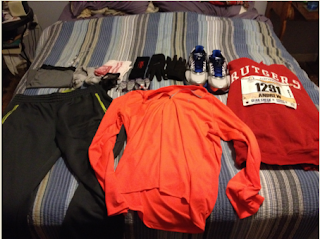 But I'm going to set that aside for a second. Two years ago, I ran the New Jersey Marathon in 4:18 in difficult conditions. I might have done 10 minutes or so better without the major headwind in the last 6 miles. About two months before that, I ran the E. Murray Todd Half Marathon in 1:56, which is just below a 9-minute pace.
But I'm going to set that aside for a second. Two years ago, I ran the New Jersey Marathon in 4:18 in difficult conditions. I might have done 10 minutes or so better without the major headwind in the last 6 miles. About two months before that, I ran the E. Murray Todd Half Marathon in 1:56, which is just below a 9-minute pace.
I am running both of those races again this spring, and so far my pace in training runs has been significantly faster -- 8:30/mile or faster on longer runs. And it feels very comfortable. I'm pretty sure I can hold that pace for 13.1, and even if I slow down for 26.2, I'll be well ahead of where I was two years ago.
So what gives? How have I gotten better?
I can speak only for myself. Others have had success with their own programs, but a few elements have helped me, and I want to share them.
Mechanics
After last year's New Jersey Marathon, where I was a volunteer and a spectator, I wrote about running form. It's not universal, but there's a clear pattern in any race: Faster runners tend to use good mechanics, and the slower the finishing times are, the more likely the runners are to have weird form. I try to focus on a few things:
 |
| Weight over my feet! |
- Mid-Foot Strike: I don't believe this is make or break for everyone, but I've found that I'm much better about keeping my weight above my feet if I focus on landing on my mid-foot instead of my heel. Otherwise, I tend to overstride and lose efficiency.
- Arm Swing: I don't allow my arms to come across my body. A little bit of twist, in conjunction with hip rotation, is OK, but more than that is a waste of energy.
- Quads and Glutes: I pay attention to which leg muscles are doing the hard work. If I feel like I'm asking too much of my calves. I try to lean forward a bit and "loosen up" to allow my quads and glutes -- the big guns -- to move my legs.
Interval Training
Two years ago, I was hit-or-miss with interval training. Without making it a regular part of your program, and doing it at least once a week, you're not going to get a lot of benefit from it. This time around, Monday is interval day, period. I don't have a complicated program -- I do three basic lengths, with half those lengths recovery.
- 400-meter repeats faster than 5k pace, with 200-meter recovery.
- 800-meter repeats around 5k pace, with 400-meter recovery. This is a bedrock of marathon training.
- Mile repeats at 10k pace with 800-meter recovery.
- One I haven't done in a while: Straights and curves. Go hard on the straights of the track, ease up around the curves. Good for explosive speed, not so much for endurance speed.
Intervals help build cardiovascular strength by forcing a lot of blood through your heart. The real work actually gets done in the recovery phase, when your heart is trying to slow down and the blood is rushing through.
Squats
 |
| courtesy Hookgrip.com |
Enter squats. Not bodyweight squats, or kettlebell squats, or dumbbell squats. Real squats with a barbell. The first time I tried them, over the summer, I found out just how much room I have for improvement. And I've made a point of working them into my marathon training.
The key, I've found, is making sure you're doing them right. Don't let your lower back do the work. Make your quads and glutes push you up. And don't cheat -- get your thighs at least parallel to the ground. If that means less weight, so be it.
Rest Days
When I started out in this training cycle, I adopted Hal Higdon's Intermediate 1 marathon plan. It involves running five days a week, with one day for cross training and one full rest day.
 |
| My running partner needs a break, too! |
So I've gone to running four days a week, with one day for cross. I'll still get plenty of miles done, and I'll have more time to rest up, heal up and push forward.
But What If You're Not Training for a Marathon?
Most Regular Guys aren't looking to run 26.2 miles, and probably never will. That's not a black mark -- in fact, my fitness regimen was much better rounded before I went into race training. But these tips aren't actually just for runners.
- Mechanics matter in any exercise. The better your form, the more you benefit and the less likely you are to get hurt.
- HIIT is a great way to work some strength into an efficient cardio routine.
- Squats are one of the most effective full-body exercises you can do, no matter your goals.
- The principles behind rest days apply to any fitness routine.
So if you're a fan of the Regular Guy mantra of Keep It Simple, Stupid, this is as good a road map as any.
What Do You Think?




